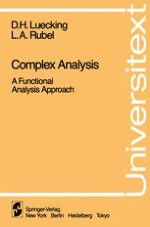1984 | OriginalPaper | Buchkapitel
The Dual of H(G)
verfasst von : D. H. Luecking, L. A. Rubel
Erschienen in: Complex Analysis
Verlag: Springer New York
Enthalten in: Professional Book Archive
Aktivieren Sie unsere intelligente Suche, um passende Fachinhalte oder Patente zu finden.
Wählen Sie Textabschnitte aus um mit Künstlicher Intelligenz passenden Patente zu finden. powered by
Markieren Sie Textabschnitte, um KI-gestützt weitere passende Inhalte zu finden. powered by
We want to prove, as in the case of the disk, that H(G)* = H0(ℂ \ G). We first study the dual of C(G). We change our notation here and write L(f) = ∫ fdμ when L ∈ C(G)*. (For the reader unfamiliar with integration theory this is simply a change in notation: The left-hand side defines the right-hand side. There are two advantages to this notation. First, it is the notation in which research papers are written. Second, the reader can call upon her experience with integration for intuition. For the mathematically advanced reader: we are invoking the Riesz Representation Theorem for C(G)*.) We call μ the “measure” associated with L, and we may identify μ and L. The collection of all such μ is denoted M0(G), so that M0(G) = C(G)*. We also write L(f) = ∫ f(z)dμ(z) when it is necessary to indicate the independent variable. “Measures” have the same properties as continuous linear functionals (which is what they are); for reinforcement, we list them here. Given μ ∈ M0(G): i)∫ (f + g)dμ = ∫ fdμ + ∫ gdμ, f, g ∈ C(G).ii)∫ afdμ = a ∫ fdμ, f ∈ C(G), a ∈ ℂ.iii)If fn → f in C(G) then ∫ fndμ → ∫ fdμ.iv)There is a compact set K ⊆ G such that | ∫ fdμ | ≤ C‖f‖K for all f ∈ C(G).
